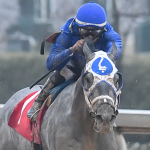
Preakness Quick Sheet: Get to Know the 2021 Preakness Horses

I don’t think I’ve ever woken up at 3 a.m. for anything other than catching a flight. And usually the night before, I’m not finished packing until 11 p.m., so I fall asleep no problem and wake up feeling like I barely closed my eyes. But the night before starting my Godolphin Flying Start externship with Chris Waller Racing (CWR) in Australia was different.
I planned ahead, going to bed at 7 p.m., only to lay awake for several hours. Nerves and thoughts churned inside my head. I was about to start working for one of the greatest trainers in the world – how do you mentally prepare yourself for that?

By attempting to remember the 500-plus horses in training with him? Reading the life story of Winx from cover to cover? She was amazing, but Chris Waller’s influence extends far beyond the legendary mare.
In just the months before I was sent to Waller, Yes Yes Yes crushed the course record in the Everest – one of the richest turf races in the world. Kolding snatched both the Group 1 Epsom Handicap and the Golden Eagle, a $7.5 million (Australian) race. During Melbourne Cup week, Nature Strip, one of the best turf sprinters in the world, practically burnt Flemington Racecourse to the ground as he blazed away in the Darley Sprint Classic.
And I was about to learn from the mastermind behind all of them.
My first day was far less nerve-wracking than I’d amped it up to be in my brain. The team patiently introduced me to the routine, and Chris’s Racing Manager and Godolphin Flying Start graduate Jack Bruce put my mind at ease by saying, “You really can’t make a mistake here … unless you saddle the wrong horse for the wrong race, and we won’t let that happen.”
“Phew, I’ve got this,” I thought to myself. “Just don’t saddle the wrong horse and I’ll be fine!”
I learned about training sheets, clocking gallops, and jumpouts, which are essentially a group of horses working in company from the gates. And I came to appreciate the significance of barrier trials – practice races typical to Australian training programs.
I knew there was no way I could retain everything I would want to remember during my three weeks, so I never went anywhere without a little, red notebook in my back pocket. I looked like “Dora the Explorer” as I walked alongside Chris or one of the team members, scribbling notes that I would type when I got home.
My favorite project was following around one of the stable veterinarians during his morning rounds, because I could ask a million questions and he would give me two million pieces of information. I accompanied him one day to visit a few of the spelling facilities used by CWR. Spelling is what we would call layup and rehab in the U.S. On the car ride, information poured out of his mouth, and my pen flew over the pages of my little, red notebook. I was always afraid of missing something valuable – a golden nugget of knowledge that would slip away if I didn’t smash it down with my pen. Seeing my concern over remembering everything, he gave me a shining piece of advice: In order to learn, you need to hear something, experience something, and teach something before it is fully absorbed. Between my notebook scribbles and pitching myself into the routine, I like to think I succeeded with the first two. Or at least I now have my very own 20-page Chris Waller Racing takeaways book.
In Australia, racecourses are categorized as country, provincial, and metropolitan, based on location, facilities, and prestige of their races. In 2019, some provincial tracks, including one called Kembla Grange, held a one-day “City-Meeting,” with a headlining $1 million race.
Never in my life did I think I would have the opportunity to saddle a Thoroughbred on race day. In the U.S., it’s generally only the trainer or assistant and jockey’s valet who do the saddling. So the memory that tops all was helping saddle a horse named Mister Sea Wolf before he won the $1 million Gong at Kembla. This was a minor contribution compared with the roles of the training team, his strapper (what we call a groom), and ownership connections. But being even a tiny part of a $1 million race winner – that’s one of those “how did I get here?” moments.
In the three weeks I was with Chris Waller Racing, it was easy to understand how he is so successful. Chris’s attention to detail in training each horse has the precision of an algorithm. His program centers around consistency and routine, which horses love. Humans also love consistency and routine, but also clarity. Everyone always knew their job, and the mornings ticked by with the reliability and steadiness of a metronome – first trip, second trip, third trip … and so on. But it all comes down to having an excellent team who deeply cares about the horses.